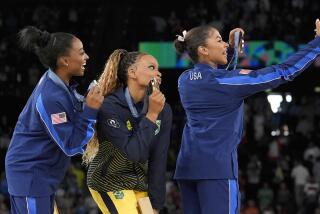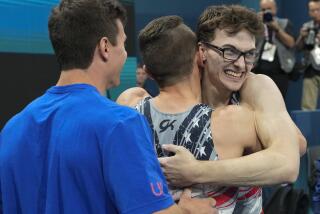Equestrian Competition Levels the Field
- Share via
Husbands compete against wives.
Teenage girls compete against 56-year-old men.
Stallions compete against mares.
With the horse as the great equalizer, there is one Olympic discipline in which male and female athletes take the measure of one another, man-to-woman-to-horse.
Whether it’s guiding a 1,100-pound steed over five-foot obstacles in show jumping, taking a high-strung mount through intricate steps in dressage or maneuvering an animal across a course of dips, turns and hills in the three-day event, the equestrian events don’t discriminate.
The United States Equestrian Federation Olympic show jumping trials continue Saturday and Sunday at the Oaks Blenheim Ranch Mission Viejo Riding Park in San Juan Capistrano. The first three of six qualifying rounds were held last weekend at Del Mar. The fourth is scheduled for Saturday and the final two Sunday.
The first- and second-place finishers are guaranteed Olympic berths. The other two positions can be filled at the discretion of the federation selection committee.
Four years ago, for the first time, an all-female team represented the U.S. This year, the men won’t be shut out. Based on an outstanding 2003 campaign, Chris Kappler of Pittstown, N.J., and his horse, Royal Kaliber, were given one of the two discretionary spots.
Of the field of 42 who began the trials, however, 28 were women.
Going into the final three rounds of qualifying, men and women are evenly divided among the top 12 places. And it’s no big deal.
Men have an advantage of strength, says Margie Engle, 2000 Olympian, but women have an advantage in gentle guidance. Usually. Some women wrangle big horses and some men can guide a stubborn horse over a jump with pliable hands and a whisper.
“Really,” Engle said, “you can’t generalize anything. We just go out and compete. It’s ultimately up to the horse anyway.”
Show jumping began in the military as an exercise for the cavalry. Hardly any civilians competed, certainly no women. According to Olympic records, only one civilian rider participated in the 1936 Olympics.
Now, nine women rank in the top 50 in show jumping and four are Americans. Beezie Madden, No. 4 in the world, is leading the Olympic trials.
“I’ve never faced any discrimination,” said Madden, 40. “Honestly, I don’t think either sex has an advantage over the other. Maybe a man can get a little edge with strength but maybe a woman has an advantage in her touch. But mostly it’s just the ability to pick the right horse.”
In 2003, Nicole and Will Simpson of Thousand Oaks became the first husband-wife team to compete in a World Cup final. Will Simpson says there is no rivalry between them.
“Nicole is the better horsewoman,” he said. “It’s as simple as that.”
So Nicole is competing in the Olympic trials and Will is along to offer moral and technical support. “We make a good team and my job is to find the horses and train them,” he said. “Nicole’s best at riding them.”
Burbank’s Richard Spooner, the top-ranking California rider in the world, said the key to show jumping was building relationships.
“In this sport, you have to think of the horses as extensions of your body,” Spooner said. “That relationship you have with the horse enables you to be good or not so good.
“Although you have to be physically fit enough not to interfere with the horse, what’s important is to facilitate your thought with your body and act out your thought on the horse’s body.
“In other words, I don’t think it makes a big difference if you are a child or adult, a girl or a man. The beauty of the sport is that you can start riding when you’re 5 years old and keep riding into your 60s. Ultimately, in this sport, it’s the horse that is the great equalizer.”
The U.S. won silver medals in show jumping at the 1988 and 1996 Olympic Games and women made up half of the four-person teams each year. In 1972, Ann Moore of Britain was the first woman to win an Olympic individual medal, a silver.
Pam Young, editor of Horse International magazine, said that women have been less prevalent in European competition not because of discrimination but because of lifestyle choices.
“It’s more a matter of some of the best women riders making the decision to have families,” Young said. So it was a lively topic of discussion in 2000 when the U.S. arrived in Australia with an all-female jumping team. Lauren Hough, a member of that team, said it had never occurred to her as a big deal.
“I mean, I never even thought there was a difference between men and women as competitors,” she said. “My dad rode in the 1952 Olympics. My mom was a professional horsewoman. “But after our team was picked last time, people really got ahold of it and many people thought we were really unique. I know it’s harder for women to earn spots in some of the top countries like Germany and Holland. I don’t know why, except those systems of picking teams tend to be more subjective, while we have a bit of objectivity in our systems.”
Melanie Smith Taylor, a show jumper in the 1970s, was given the rider-of-the-year and the lady-rider-of-the-year awards in 1978 by the American Grandprix Assn. Her sweep ended any separate-but-equal ideas in the association.
“The next year,” Taylor said from her home in Memphis, “they only gave one award. I guess maybe we women were making it redundant.”
So who has the advantage?
“I’ve always felt the best competitor was a man who could ride like a woman, be strong yet soft with finesse,” Taylor said. “Or was it the woman who could ride like a man? Either way. That’s the perfect rider.”
More to Read
Go beyond the scoreboard
Get the latest on L.A.'s teams in the daily Sports Report newsletter.
You may occasionally receive promotional content from the Los Angeles Times.






